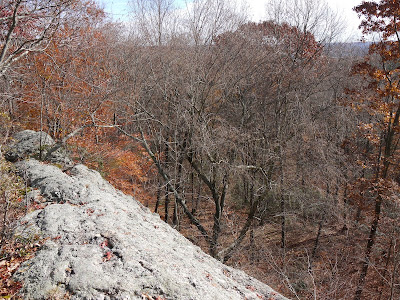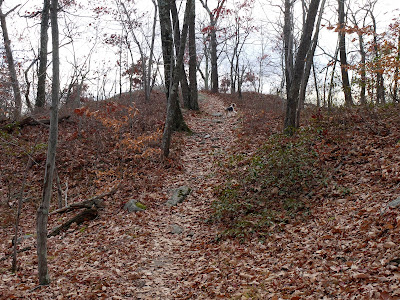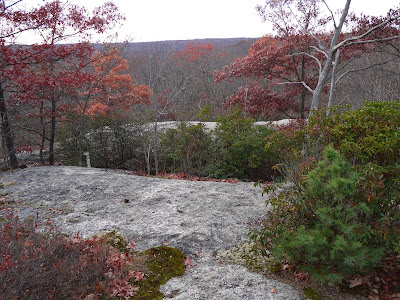 |
| Seven Falls State Park picnic area |
Upon reaching Brainard Hill Road, the trail follows the roadway for quite awhile, crossing the expressway called Rt 9, to arrive at Seven Falls State Park. I experienced the road stretch in the best possible way, from the comfort of my car. A lot faster that way. And I'd just like to mention that every town should have a "Nedobity Road."
 |
| This is it? |
Seven Falls State Park was not what I expected. First of all, aside from a modest picnic area and parking lot, it was all woods. Which is fine with me, of course. Being a state park, I thought there might be more in the way of facilities. Upon doing some Googling at home, I found it listed as an "early roadside park" administered by the CT DOT. That's different. According to the Haddam Historical Society, "The stop over was the state's first rest area and was extremely popular when Route 154 was the main road from Hartford/Middletown to the Connecticut shoreline."
Second, I sort of assumed there would be some waterfalls, but there really weren't. Perhaps due to the drought, or maybe I just missed it. At the picnic area there is a prominent boulder field that Bible Rock Brook passes through, and I'm sure that's normally very lovely when there is more water in the brook, but it was down to a trickle when I visited (much of Connecticut is now officially in a drought).
 |
| Leaves the color of pumpkin pie |
I love November hiking. It's cool and crisp, no bugs, fewer crowds, and the views get better as the leaves fall. The freshly fallen leaves and occasional red berries hint of pumpkin pie and stuffing spiked with cranberries. All I need now is a turkey running across my path.
 |
| Pin Cherry (?) under the powerlines. Or hanging cranberries, if you prefer. |
A major powerline corridor is a prominent feature of this park. I don't mind the powerlines for hiking. Sometimes they offer the best views of the day, and it's Connecticut, so what do you expect? The blue blazes led us up and over rock knobs under the powerlines.
 |
| And the blazes say...trail goes up. |
Rock. Lots of it. Rocky knobs, cliffs, overhangs. Rock underfoot. Dramatic rock. In summary, there is a lot of rock in this park. I suspect this area was never farmed much. The going was slower than the previous hike as the trail wind up, over, and around all the rock.
 |
| A lone pine somehow manages to grow out of the rock. |
After following the powerlines for a bit, the trail heads into woods filled with dramatic outcrops. It's normally to see some good outcrops on any hike in Connecticut, but this stretch of trail had more than it's fair share.
 |
| Just some more rock. |
 |
| White Oak |
Tree of the day: White Oak. It has light crackled bark, rather than the long dark furrows the oaks usually have. Plus, it often has "Smooth Patch Disease", a fungus that causes patches of the bark to fall away near the base.
 |
| Smooth Patch Disease - Common in White Oaks |
 |
| Fewer leaves = more views |
With all the fallen leaves on this rocky trail, my pair of trekking poles came in very handy. I still managed to fall at one point when a leaf-covered cobble rolled under my foot. I would not do this hike in wet weather as the rock could be slick.
 |
| More rock... |
 |
| Trail blazes lead straight up this rock |
 |
| Highbush Blueberry |
At one point the blazes led straight up a vertical rock face. As always, I thought it might be a joke. It never is. There were more blazes up on top. So I did what any reasonable non-goat person would do...I found a way around the rock. Judging from the beaten path around the rock, a lot of other people made the same choice.
Eventually the trail reached Aircraft Road, which would have been a lot more interesting if the road doubled as a landing strip.
 |
| Aircraft Road, sadly with no aircraft. |
After reaching the road, I returned via the Seven Falls Loop Trail, blazed blue/yellow. The trail was easy enough to follow and some of the blazes were a little worn, but not too bad.
 |
| Dried up stream crossing |
Although it was a school holiday, the only people I saw the entire day are in the above picture, way down below.
I'll sign off with some shots of red berries.
 |
| Winterberry (native shrub) |
 |
| Asiatic Bittersweet (a highly invasive vine) |
 |
| Wintergreen |























































